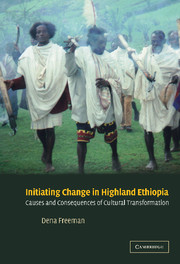Book contents
- Frontmatter
- Contents
- List of illustrations
- Acknowledgements
- Select glossary
- 1 Introduction: theorising change
- 2 The recent history of the Gamo Highlands
- 3 Production and reproduction
- 4 The sacrificial system
- 5 The initiatory system
- 6 Experiencing change
- 7 Assemblies and incremental cultural change
- 8 Transformation versus devolution: the organisational dynamics of change
- Notes
- Bibliography
- Index
7 - Assemblies and incremental cultural change
Published online by Cambridge University Press: 22 September 2009
- Frontmatter
- Contents
- List of illustrations
- Acknowledgements
- Select glossary
- 1 Introduction: theorising change
- 2 The recent history of the Gamo Highlands
- 3 Production and reproduction
- 4 The sacrificial system
- 5 The initiatory system
- 6 Experiencing change
- 7 Assemblies and incremental cultural change
- 8 Transformation versus devolution: the organisational dynamics of change
- Notes
- Bibliography
- Index
Summary
In the last chapter we saw how the changing patterns of production in the nineteenth and twentieth centuries created new economic realities and new social situations for the people of Doko, and how people responded to these new situations by changing their actions in everyday and cultural life. We saw that these changes were often contested, as certain people stood to lose out by the changing actions of those with whom they interacted, and we also saw how the community would sometimes make decisions to change cultural practices so that they were better suited to the contemporary situation. In this chapter we will look at the process of communal decision-making and consider the ways in which changes in individual circumstances and actions led to communally sanctioned changes in cultural practices.
Strategy and individual change
It is a basic truth that all people want to make the best of their situation and will develop strategies to further their own interests and improve their own lives. These strategies are not necessarily carefully thought out action plans, but are rather sets of strategic decisions that people make as they interact with other people. As changes in the social and economic context alter both personal circumstances and the opportunities that are open to individuals, people begin to make different decisions in what, to the outsider, might look like the same type of interaction. In other words, as the context changes people modify their strategies in order to benefit from the new context.
- Type
- Chapter
- Information
- Initiating Change in Highland EthiopiaCauses and Consequences of Cultural Transformation, pp. 130 - 150Publisher: Cambridge University PressPrint publication year: 2002



